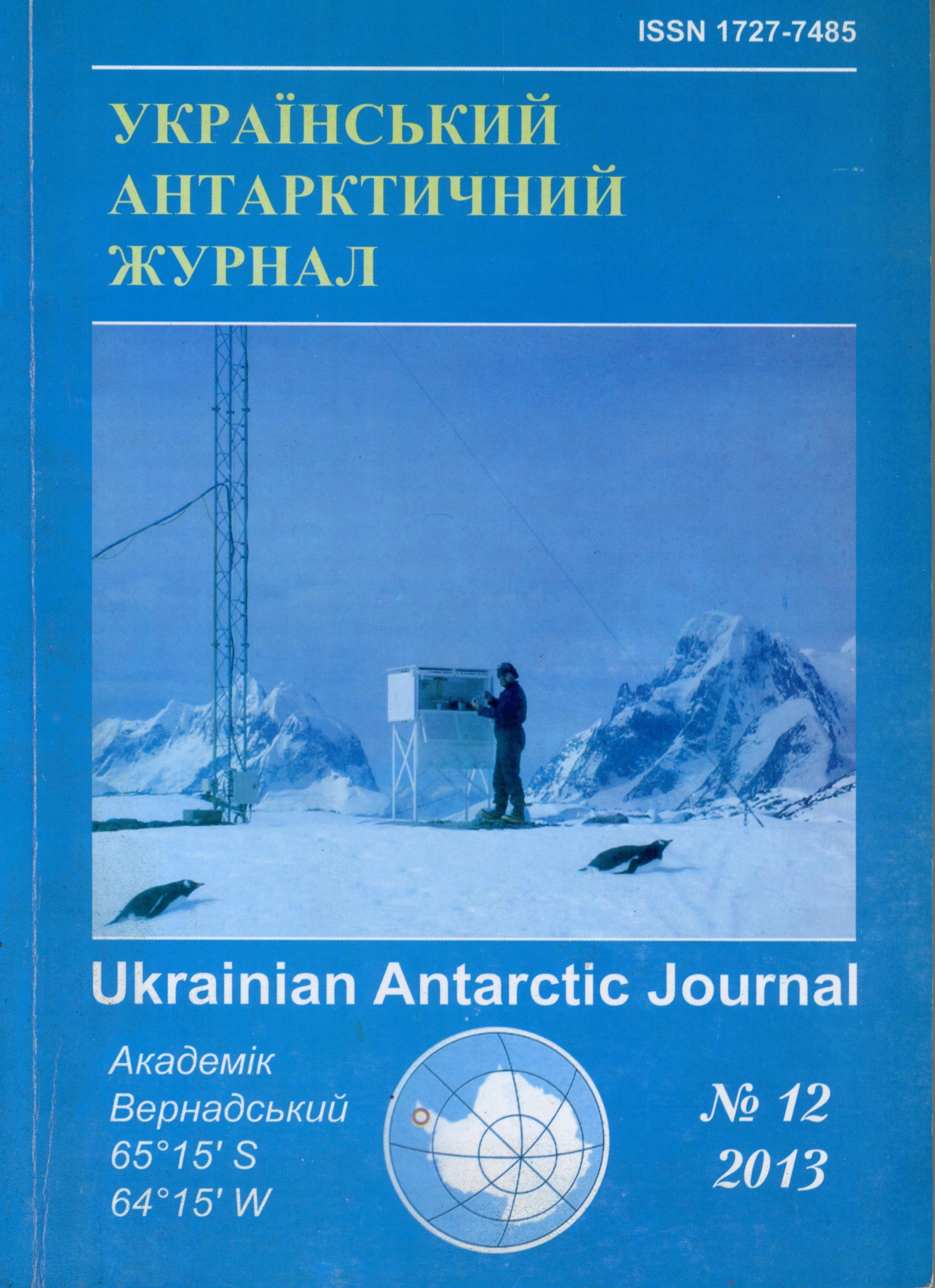- sea-ice,
- air and sea surface temperature,
- atmospheric circulation,
- circulation index,
- El Nіño index
Анотація
Площа морського льоду в Антарктиці зростає протягом більшості місяців року, з максимумом у березні-травні – перехідному сезоні, коли відбувається формування сезонної криги. Протягом літнього сезону в акваторіях на захід від Антарктичного п-ва виявлено багаторічне відступання морського льоду на тлі значних міжрічних коливань. Аномалія у стані льодового покриву супроводжується аномалією в полях температури повітря та поверхні океану й зумовлюється певним типом циркуляції атмосфери. Складна льодова ситуація під час літніх сезонів спостерігається на тлі від’ємної аномалії температури повітря і південної складової вітру. Дослідження дозволило знайти потенціал сезонної передбачуваності аномалії льодового покриву. До переліку предикторів увійшли індекс Ель-Ніньйо, індекси регіональної циркуляції атмосфери, температура повітря і морської води в районі станції Академік Вернадський. Для оцінки розвитку аномалії потрібно виявити момент початку весняного відступання криги, пов’язаного з переходом температури через 0°С. Важливе прогностичне значення має певна інерція процесу на сезонному часовому масштабі. Окремо проаналізовано льодову аномалію літнього сезону 2011-2012 рр., коли на станції Академік Вернадський вперше за багато років був перерваний плановий хід сезонних робіт. Показано типи атмосферної циркуляції, сприятливі для розвитку льодової аномалії.
Посилання
- Atlas okeanov. Antarktika [Atlas of oceans. Antarctica]. (2005). GUNO MO RF. St. Petersburg.
- Bulgakov, M.P., Artamonov, Yu.V., Grishhenko, V.F. et al. (2000). Osobennosti ledovy`x uslovij v rajone Antarkticheskogo poluostrova i morya Skotiya osen`yu 1998 g. po danny`m Vtoroj ukrainskoj antarkticheskoj e`kspedicii [Specifics of ice conditions in the region of the Antarctic Peninsula and Scotia Sea in late 1998 by the data of the Second Ukrainian Antarctic Expedition]. Dokl. NAN Ukrainy`, 2, 107–110.
- Grishhenko, V.F., & Timofeev V.E. (2005). Reakcii komponentov glyaciosfery` na izmeneniya klimata v rajone Antarkticheskogo poluostrova [Reactions of the components of the glaciosphere on the climate changes in the Antarctic Peninsula region]. Ukrainian Antarctic Journal, 3, 99–107.
- Gruza, G.V., Ran`kova, E.Ya., & Rocheva, E.V. (2007). Krupnomasshtabny`e kolebaniya atmosfernoj cirkulyacii v Yuzhnom polusharii i ix vliyanie na izmenenie klimata v nekotory`x regionax planety` v XX stoletii [Large-scale oscillations of atmospheric circulation in the Southern Hemisphere and their effect on the climate change in some regions of the planet in XX century]. Meteorologiya i gidrologiya, 7, 5–17.
- Kotlyakov, V.M. (Ed.). (1992). Rezhim i e`volyuciya polyarny`x lednikovy`x pokrovov [Regime and evolution of the polar ice sheet covers]. S.Petersburg, Gidrometeoizdat.
- Martazinova, V.F., Timofeev, V.E., & Ivanova, E.K. (2008). Costoyanie cirkulyacii nizhnej troposfery` Yuzhnoj polyarnoj oblasti v period sovremennogo potepleniya [The state of the circulation of the lower troposphere in the Southern Polar region furing the current warming]. Ukrainian Antarctic Journal, 6-7, 175–183.
- Martazinova, V.F., Timofeev, V.E., & Ivanova, E.K. (2010). Atmosfernaya cirkulyaciya Yuzhnoj polyarnoj oblasti i klimat Antarkticheskogo poluostrova [Atmospheric circulationof the Southern Polar region and the climate of the Antarctic Peninsula]. Kyiv.
- Klimaticheskij rezhim Arktiki na rubezhe XX i XX1 vv. [Climatic regime of the Arctic at the border of XX and XXI centuries] (1991). S.-Petersburg, Gidrometeoizdat.
- Maslennikov, V.V. (2003). Klimaticheskie kolebaniya i morskaya e`kosistema Antarktiki [Climatic oscillations and the marine ecosystem of Antarctica]. Moscow, Izd. VNIRO.
- Peklo, A.M. (2007). Pticy Argentinskix ostrovov i ostrova Piterman [Birds of the Argentine Islands and the Petermann Island]. Krivoj Rog, Mineral.
- Popov, V.I., & Skry`pnik, V.V. (2003). Antarkticheskij zhurnal, 1, 79–84.
- Carleton, A.M. (1989). Antarctic sea–ice relationships with indices of the atmospheric circulation of the Southern Hemisphere. Climate Dynamics, 3, 207–220.
- Cavalieri, D.J., Parkinson, C.L., & Vinnikov, K.Y. (2003). 30-year satellite record reveals contrasting Arctic and Antarctic decadal sea ice variability. Geophysical Research Letters.
- Gillett, N.P., Kell, T.D., & Jones, P.D. (2006). Regional climate impacts of the Southern Annular Mode. Geophysical research Letters, 34, L23704.
- Harangozo, S.A. (1997). Atmospheric meridional circulation impacts on contrasting winter sea ice extent in two years in the Pacific sector of the Southern Ocean. Tellus, 49(3), 388–400.
- Harangozo, S.A. (2000). A search for ENSO teleconnections in the west Antarctic Peninsula climate in Austral winter. International Journal of Climatology, 20, 663–679.
- Heap, J.A. (1965). Antarctic pack ice. In T. Hatherton (Ed.), Antarctica. Praeger. pp. 187–196.
- Hinzmann, L.D. et al. (2005). Evidence and implications of recent climate change in Northern Alaska and other Arctic regions. Climatic Change, 72, 251–298.
- Holland, P.R., Kwok, R. (2012). Wind-driven trends in Antarctic sea-ice drift. Nature Geoscience, 5, 872–875.
- Kawaguchi, S., Nicol, S., Taki, K., & Naganobu, M. (2006). Fishing ground selection in the Antarctic krill fishery: trends in patterns across years, seasons and nations. Commission for the Conservation of Antarctic Marine Living Resources Science, 13, 117–141.
- King, J.C., & Harangozo, S.A. (1998). Climate change in the western Antarctic Peninsula since 1945: observations and possible causes. Annals of Glaciology, 27, 571–575.
- Kwok, R., & Comiso, J.C. (2002). Spatial patterns of variability in Antarctic surface temperature: connections to the Southern Hemisphere Annular Mode and the Southern Oscillation. Geophysical Research Letters, 29, 50-1–50-4.
- Van Loon, H., & Shea, D.J. (1985). The southern oscillation part IV: the precursors south of 15 °S to the extremes of the oscillation. Мonthly Weather Review, 113, 2063–2074.

